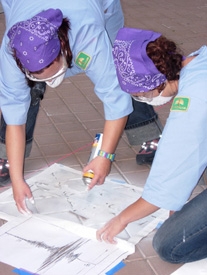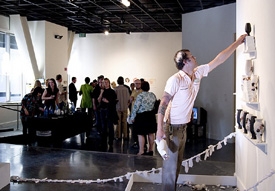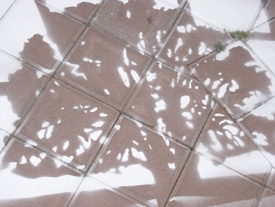Feature: Reviews
Form/Reform at the OAG
- Oakland Art Gallery
- Oakland, California
I made it out to Thursday’s opening of Form/Reform at the Oakland Art Gallery, which technically was not a Bayenale event as the Bayennale didn’t “open” until Friday, but as said exhibition runs through the Bayenale, I consider it part of the shebang. The Form/Reform show of performance art and documentation thereof was uneven, though reliance on documentation of a work often results in a lower estimation of the original work than were you to witness said original work or be familiar with it, much the same way one thinks differently (and often less) of paintings or sculpture one experiences only in photos in magazines or catalogs. Exhibitions of performance art (and conceptual art for that matter) are a tricky business. Exhibition strategy, including the choice of how to present the documentation, is an art in itself, or at least a separate craft than creating the “original.” (If indeed the work is somehow separate from its documentation.)
Form/Reform was a mixture of documentation and actual performance (some via video). In general the performed works were stronger than those with exhibition presences that were just documentation or ephemera, with the exception of the DVD by Dale Hoyt and Hailey Ashcraft, which was performed for video.
The big crowd pleaser was Brion Nuda Rosch’s carnival vase breaking game which invited gallery attendees to throw taped-together sock balls at a vertical pyramid of ceramic vases with the goal of knocking one or more off their shelves, causing them to fall and break in the box below. Perhaps it’s the influence of Marioni’s beer drinking, but Bay Area performance art often tries to be entertaining. Does providing fun and games make the work less worthy than more puritanical performance modes? It is often more challenging to a critic to evaluate or analyze, because fun & games art—entertainment art—appropriates criteria from non-art. Your knee-jerk reaction is to judge Rosch’s performance on how fun it was or how successful it was at its appropriation or simulation (e.g. the guy performing as carnival barker had the patter down really damn good). Rosch’s piece navigated the performance/exhibition dilemma quite well, with the broken vase remnants providing an interesting visual composition that isn’t too oblique in its reference to the performance.
The other big hit of this opening (in terms of audience attention) was another fun & games art project, Brian Storts’s Portrait of Your Stupid Face in which (at least during the time I was there) the portraits were drawn by a little kid (approximate age, five). Storts’s statement of his project has him doing the drawings, but the little kid was a better choice. The fact the drawings all looked the same (different hair styles, same face) was an unintentional comment on studio portraiture. I don’t know whether Storts’s own portraits would have all looked the same or have been drawn in a childlike manner. I also don’t know if the little kid artist was planned by Storts or was a flash of momentary “brilliance.” The portraits tacked on the wall don’t really hold their own, which doesn’t necessarily make Storts’s project “bad.” They rely on supplementary information—that they were drawn by a five-year-old boy wearing a suit to the opening attendees’ amusement. I can imagine the conversation of people viewing the exhibition during regular
gallery hours:
A: These look like a little kid drew them.
B: A little kid did draw them. He was at the opening. It was really funny.
A: Oh really? That’s funny.
Jessica Tully’s paper cut outs of her Oakland Walk of Fame and Jim Tantum’s writing down of things he missed on a large sheet of paper on the gallery wall weren’t fun & games pieces. Though Tully attracted a waxing and waning audience outside watching her process, few were paying close attention for significant periods of time. It was performance art that functioned like background music at a party. This could be another Marioni-related performance strategy. Tully’s historical reclamation project and Tantum’s personal inventory follow contemporary trends in art practice, especially in the Bay Area, where community-oriented public art projects can command large grants in a dwindling pool of arts funding. Simon Evan’s recent showing in the SFMoMA SECA show and the recurring presence of emigre Chris Johannson shows that the SF Bay Area art scene continues its love affair with the abject. I don’t want to demean Tully’s or Tantum’s work by calling what they do “trendy.” I’d like to reserve judgment on Tully’s piece until I see how it’s “installed” in public.
The works that, at least for this opening, relied solely on documentation required a bit more focus or initiative. One’s feelings about how much initiative should be taken by a viewer will effect one views the success of some of these pieces. Paul Zografakis’s Fanfare float required little initiative by the viewer in that it was aggressively flashy and adhered to one’s expectations of the object it was simulating; it was also obvious in its function as a placeholder for a live performance that was to occur at another time. In contrast, Jon Brumit’s sound works were presented on an iMac computer (again with headphones), using the artist’s Web site as interface.
The computer suffers even more than the video monitor in an exhibition context. Perhaps it’s the extra-contextual associations with “work,” but art displayed on computers that aren’t mere self-presenting slideshows often becomes art uninvestigated. There are certain exceptions, but Brumit’s work was not one of them. In fact, the computer website display puts Brumit’s work at a greater disadvantage than most other art work that could be exhibited in this manner. Were this exhibition to have been titled You Just Had to Be There this piece would have worked well. Unfortunately, this wasn’t the case. Brumit’s strengths as a sound artist are his sense of play in a live context, his facility at improvisation, and his unorthodox choice of materials/instruments. While his recorded efforts are good, they do not distinguish themselves from a lot of other recorded music in its genre. Being told in html that this sound was made by “shaving” a stuffed animal with electric hair clippers is not as compelling as watching Brumit pick up the clippers and witnessing his facial expression as he selects the stuffed animal, and shaves it.
Elizabeth DiGiovanni’s public decorator project showed the results of her decoration on a video monitor against a backdrop of festive deep red textured wrapping paper. The presentation was quite striking, and the project worked well, even “reduced” to documentation on a video monitor, perhaps partly because in its publicness and decorativity it referred to installing and exhibiting art. Mark Morris’ video didn’t succeed quite so well, perhaps for mere technical reasons involving the physical properties of sound. Exhibiting video art with an integral sound component is challenging, especially when there are multiple works and the exhibition space is small. Perhaps the eye-candy projection genre with no or ambient sound is so popular because it’s easier to integrate and exhibit for the great majority of arts spaces designed for and used to showing wall based work—paintings, drawings and photography.
Even with limited options, video art with integral soundtracks can be exhibited in a manner to “pull the audience in.” Dale Hoyt’s and Hailey Ashcraft’s videos did a better job of this than Morris’, though both were “limited” to monitors with headphones. Hoyt & Ashcraft provided their own attractively designed benches for the audience and a monitor on similar furniture at eye level of one seated on the bench. This furniture was first deployed in an exhibition Ashcraft curated earlier this year. Perhaps the different aesthetics of the two videos also were at play. Morris’s video with its high chroma and energetic game show contestants certainly would have benefited by some public audibility, even at a relatively low level. The nature of Morris’s imagery is psychologically associated with abrasive yelling and cheering and loud music and sound effects, to effectively communicate with the stereotypical housewife viewer in the kitchen, thus through that association, one’s impulse is to step back from it. Ashcraft’s video, by contrast, in cool black and white and a slower rhythm, visually invited a viewer closer, closer to the benches and the headphones that conveyed the “rest” of the work.
I am curious and eager to see next Thursday’s performances, which will showcase a number of other artists, whose work was not on display at this first opening.



